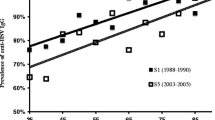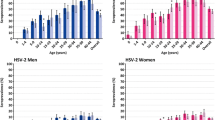Abstract
The aim of this study was to investigate the seroprevalence of herpes simplex virus type 1 (HSV-1) and type 2 (HSV-2) in representative samples of the total former East German (FEG) and total former West German (FWG) populations. Type-specific testing with the HSV-1 (gG1) and HSV-2 (gG2) indirect ELISA was performed on an age- and sex-stratified random subsample of 3,792 sera collected during the 1997–1998 German National Health Survey. Weighted seroprevalence estimates were calculated for the total FEG and FWG populations. The overall age-standardised seroprevalence of HSV-1 was 82.6% in Germany, 85.5% (95%CI, 83.4–87.3%) in FEG and 81.8% (95%CI, 79.9–83.6%) in FWG. The overall seroprevalence of HSV-2 was 13.3% (95%CI, 11.8–14.9) in Germany, 16.5% (95%CI, 14.1–18.9) in FEG and 12.6% (95%CI, 10.7–14.5%) in FWG. The difference between FEG and FWG was largely due to the significantly higher age-adjusted seroprevalence of HSV-1 and HSV-2 in women (but not men) in FEG as compared to FWG. The HSV seroprevalence estimates in this study are consistent with results of previous less representative seroprevalence studies in Germany. Differences in HSV-2 seroprevalence between FEG and FWG suggest differences in sexual behaviour that warrant further investigation.


Similar content being viewed by others
References
Corey L (1994) The current trend in genital herpes: progress in prevention. Sex Transm Dis 21 (Suppl):S38–S44
Wald A, Link K (2002) Risk of human immunodeficiency virus infection in herpes simplex virus type 2-seropositive persons: a meta-analysis. J Infect Dis 185:45–52
Rabenau HF, Buxbaum S, Preiser W, Weber B, Doerr HW (2002) Seroprevalence of herpes simplex virus types 1 and type 2 in the Frankfurt am Main area, Germany. Med Microbiol Immunol (Berlin) 190:153–160
Chenot JF, Rabenau HF, Doerr HW (1999) Virologie, Epidemiologie und Diagnostik des Herpes genitalis. Dtsch med Wschr 124:158–162
Bahrdt B, Rabenau B, Weber B, Eibner J, Doerr HW (1992) Prävalenz Herpes simplex-Virus-Typ-2-spezifischer Antikörper bei personen mit unterschiedlichem Infek tionsrisiko. Z Hautkr 67:56–58
Wutzler P (2000) Seroporevalence of herpes simplex virus type 1 and type 2 in selected German populations—relevance for the incidence of genital herpes. J Med Virol 61:201–207
Pebody RG, Andrews N, Brown D, Gopal R, de Melker H, Francois G, Gatcheva N, Hellenbrand W, Jokinen S, Klavs I, Kojouharova M, Kortbeek T, Kriz B, Prosenc K, Roubalova K, Teocharov P, Thierfelder W, Valle M, Van Damme P, Vranckx R (2004) The seroepidemiology of herpes simplex virus type 1 and 2 in Europe. Sex. Transm. Infect 80:185–191
Thefeld W, Stolzenberg H, Bellach B-M (1999) Bundes-Gesundheitssurvey: Response, Zusammensetzung der Teilnehmer und Non-Responder-Analyse. Gesundheitswesen 61 (Suppl 2):S57–S61
Gopal R, Gibbs T, Slomka MJ, Whitworth J, Carpenter LM, Brown DW (2000) A monoclonal blocking EIA for herpes simplex virus type 2 antibody: validation for seroepidemiological studies in Africa. J Virol Methods 87:71–80
Nahmias AJ, Lee FK, Nahmias BS (1990) Sero-epidemiological and -sociological patterns of herpes simplex infections in the world. Scand J Infect Dis 69 (Suppl.):19–36
Wutzler P, Färber I, Eichhorn U, Helbig B, Sauerbrei A, Brandstädt A (1999) Zur Seroprävalenz von Herpes simples-Virus Typ 2 (HSV-2) in Thüringen. Bundesgesundheitsbl—-Gesundheitsforsch—Gesundheitsschutz 42:776–782
Enders G, Risse B, Zauke M, Bolley I, Knotek F (1998) Seroprevalence study of herpes simplex virus type 2 among pregnant women in Germany using a type-specific immunoassay. EJCMID 17:870–872
Bundeszentrale für gesundheitliche Aufklärung (2002) Jugendsexualität. Wiederholungsbefragung von 14- bis 17-Jährigen und ihren Eltern. Ergebnisse der Repräsentativbefragung aus 2001. Bundeszentrale für gesundheitliche Aufklärung, Köln
Wald A, Langenberg AGM, Link K, Izu AE, Ashley R, Warren T, Tyring S, Douglas JM, Corey L (2001) Effect of condoms on reducing the transmission of herpes simplex virus type 2 from men to women. JAMA 285:3100–3106
Statistisches Bundesamt (2000) Statistik der Meldepflichtige Erkrankungen—Geschlechtskrankheiten. Metzler Poeschl, Wiesbaden
Vyse AJ, Gay NJ, Slomka MJ, Gopal R, Gibbs T, Morgan-Capner P, Brown DW (2000) The burden of infection with HSV-1 and HSV-2 in England and Wales: implications for the changing epidemiology of genital herpes. Sex Transm Infect 76:183–187
Mertz GJ, Benedetti J, Ashley R, Selke SA, Corey L (1992) Risk factors for the sexual transmission of genital herpes. Ann Intern Med 116:197–202
Langenberg AGM, Corey L, Ashley RL, Leong WP, Straus SE, for the Chiron HSV Vaccine Study Group (1999) A prospective study of new infections with herpes simplex virus type 1 and type 2. N Engl J Med 341:1432–1438
Ross JDC, Smith IW, Elton RA (1993) The epidemiology of herpes simplex types 1 and 2 infection of the genital tract in Edinburgh 1978–1991. Genitourin Med 69:381–383
Nilsen Q, Myrmel H (2000) Changing trends in genital herpes simplex virus infection in Bergen, Norway. Acta Obstet Gynecol Scand 79:693–696
Löwhagen GB, Tunbäck P, Andersson K, Bergström T, Johannisson G (2000) First episodes of genital herpes in a Swedish STD population: a study of epidemiology and transmission by the use of herpes simplex virus (HSV) typing and specific serology. Sex Transm Infect 76:179–182
Wolff MH, Schmitt J, Rahaus M, Dudda H, Hatzmann W (2002) Clinical and subclinical reactivation of genital herpes virus. Intervirology 45:20–23
Thierfelder W, Bergmann KE, Hellenbrand W, Seher C, Tischer A, Thefeld W (2002) Laboruntersuchungen im Kinder- und Jugendgesundheitssurvey. Gesundheitswesen 64 (Suppl 1):S23–29
Acknowledgements
We thank Mrs. Ingrid Gabriel for performing the serological testing at the Robert Koch-Institute and Dr. Robin Gopal for completing the in-house-testing at the Enteric, Respiratory, and Neurological Virus Laboratory, Central Public Health Laboratory, London. We thank Dr. Eckard Bergmann from the Robert Koch-Institute for advice on the statistical analysis and Dr. Richard Pebody from the Communicable Disease and Surveillance Centre, London, for his role as coordinator of the EU project to which this study contributed. The MRL Diagnostics test kits were supplied by Glaxo-Wellcome, UK, as part of the funding for a European study on HSV seroprevalence.
Author information
Authors and Affiliations
Corresponding author
Rights and permissions
About this article
Cite this article
Hellenbrand, W., Thierfelder, W., Müller-Pebody, B. et al. Seroprevalence of herpes simplex virus type 1 (HSV-1) and type 2 (HSV-2) in former East and West Germany, 1997–1998. Eur J Clin Microbiol Infect Dis 24, 131–135 (2005). https://doi.org/10.1007/s10096-005-1286-x
Published:
Issue Date:
DOI: https://doi.org/10.1007/s10096-005-1286-x




